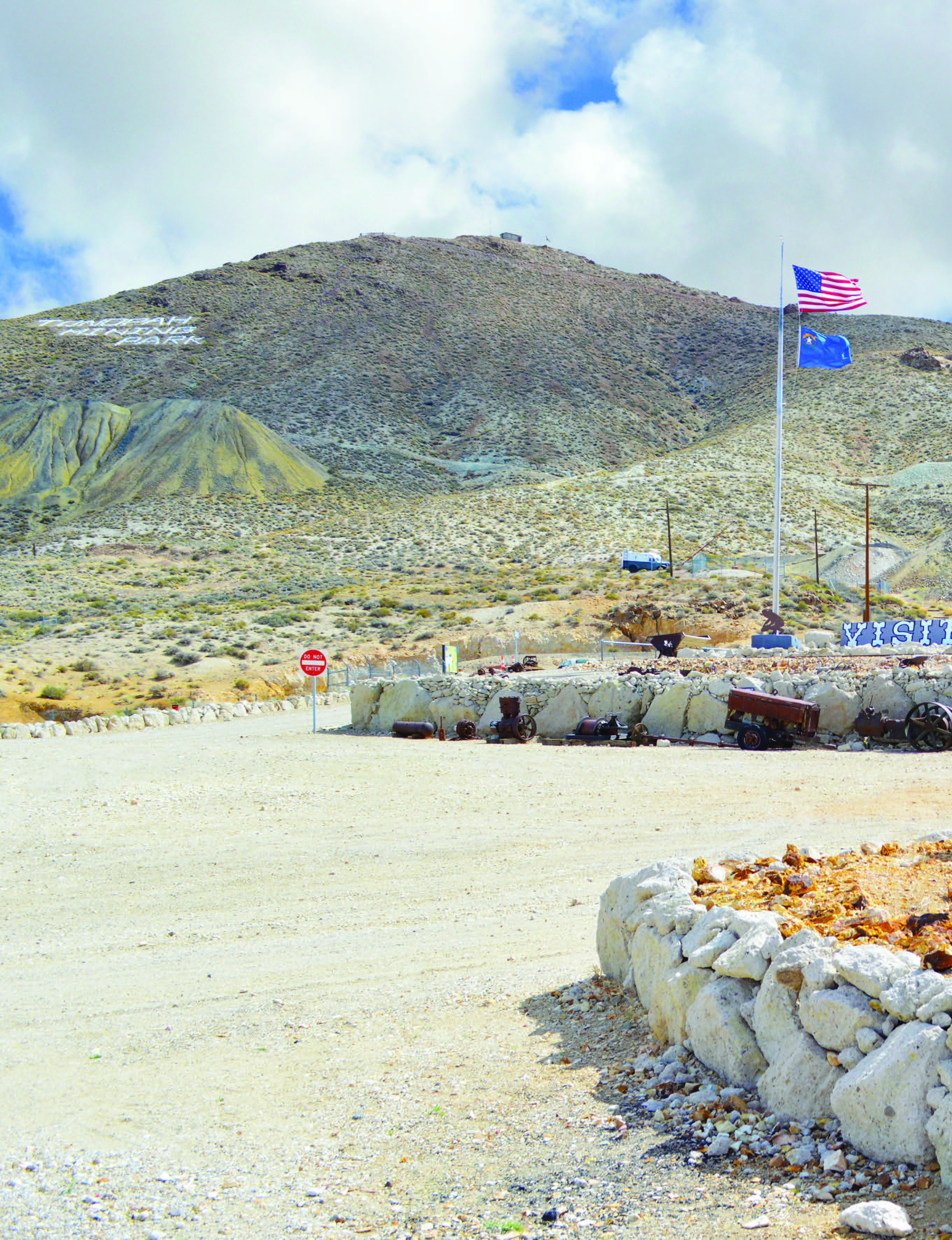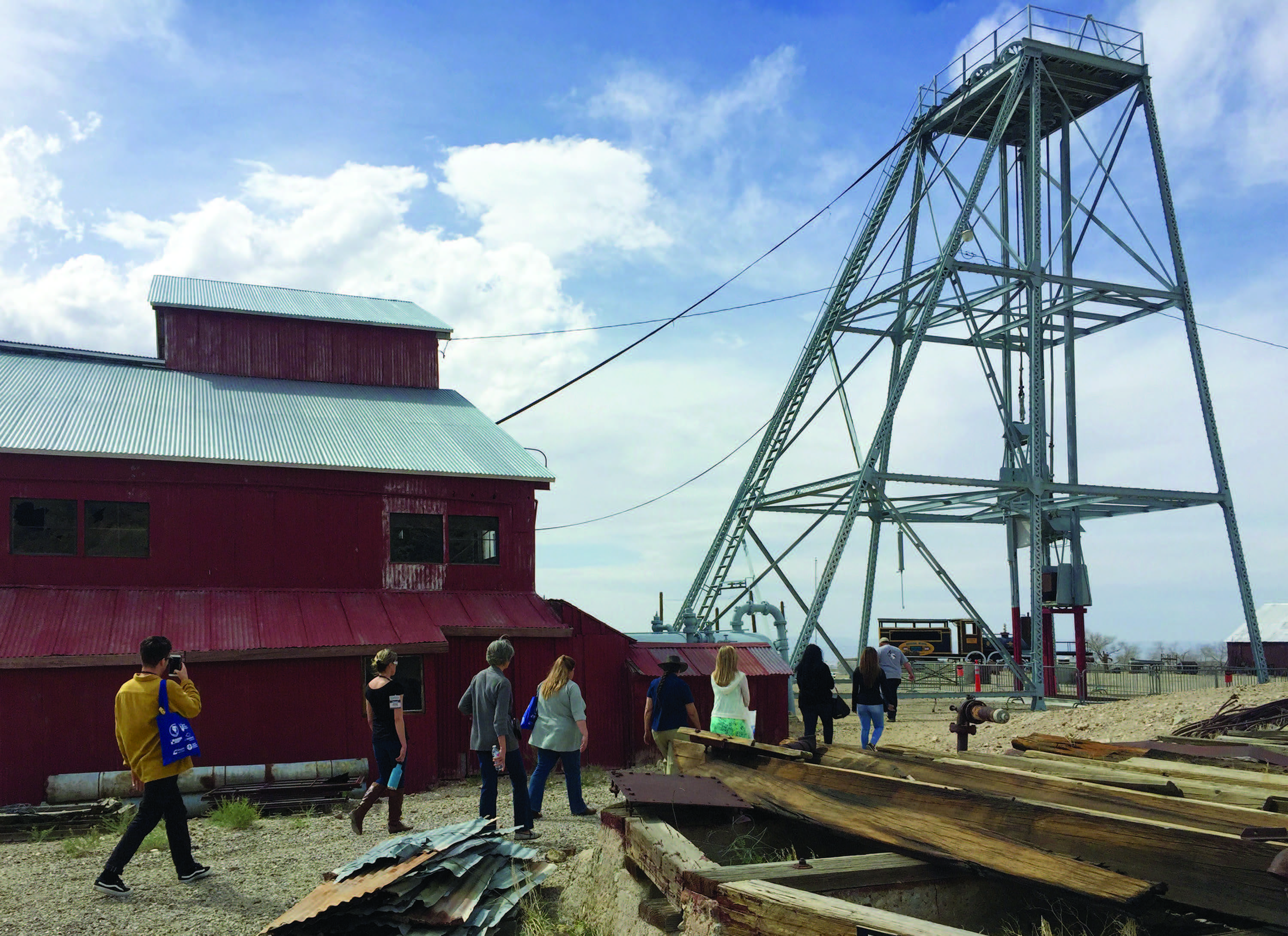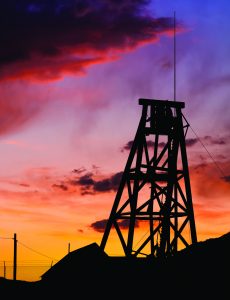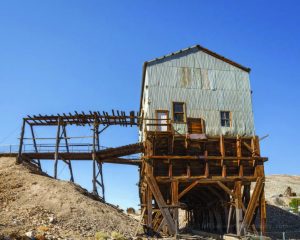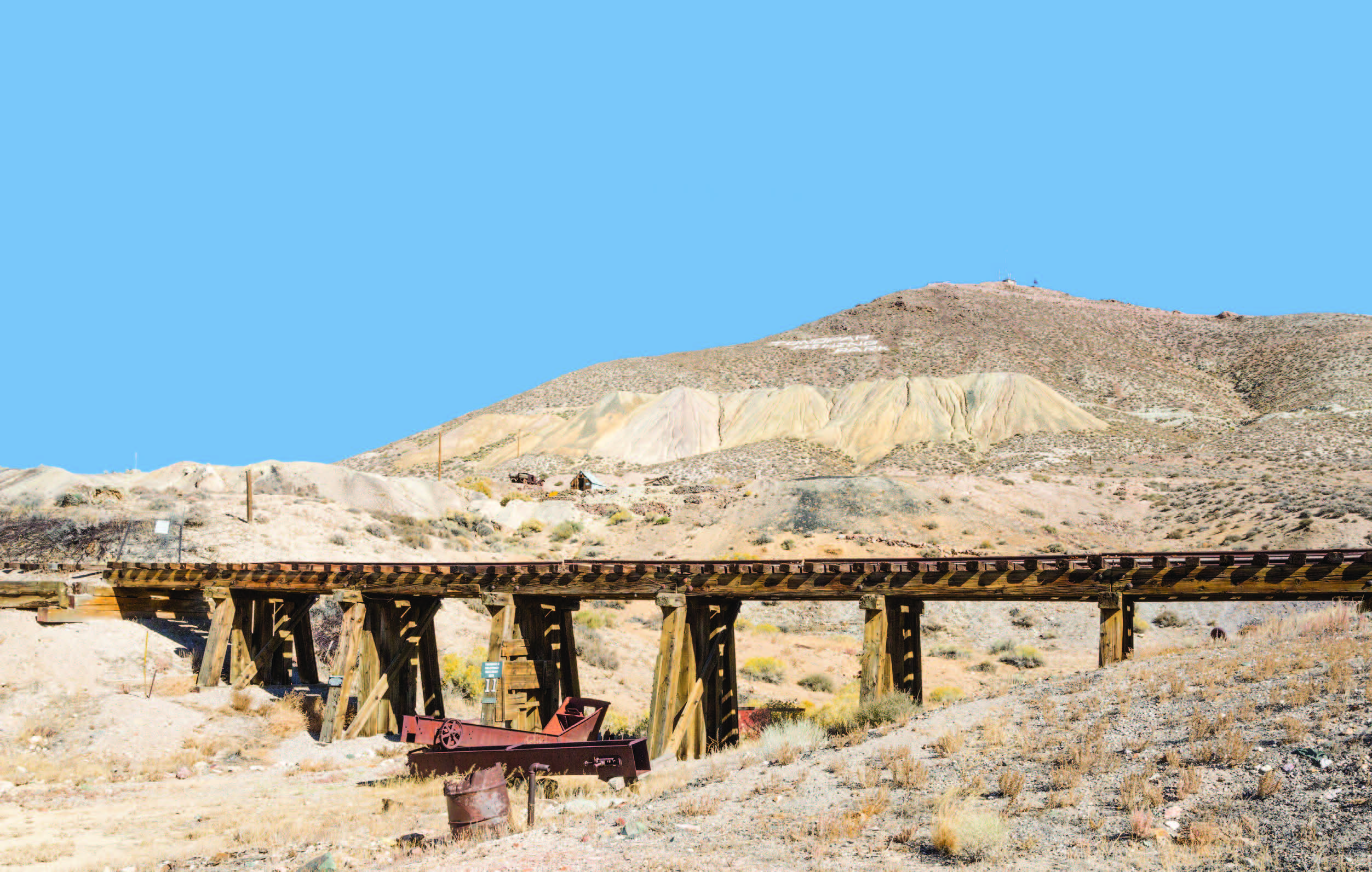Tonopah Historic Mining Park
July – August 2018
Tonopah
BY ERIC CACHINERO
In the days of old, miners seldom just stumbled upon massive silver strikes. That’s because silver ore doesn’t exactly look like the shimmering, polished metal found in wedding bands and werewolf bullets.
Silver ore is oftentimes an amalgamation of many different types of minerals, and usually requires an assay to determine if it holds enough silver to turn a profit.
Striking it rich wasn’t just as simple as seeing a profitable rock at a distance and having the promise of riches spelled out for you.
But these aren’t the days of old anymore, and sometimes the promise of something great is actually, literally spelled out for you in the rocks. Such is the case as you crest the hill into Tonopah and the whitewashed rocks that adorn the hillside of Mt. Oddie come into focus, reading: TONOPAH MINING PARK. Though your promise of riches has effortlessly revealed itself, it wasn’t always the case for the men and women that discovered the rocks that would come to be known as the Queen of the Silver
Camps. And while their entire lives were on the line for the silver that was pulled from the hills, yours probably isn’t when you park your air-conditioned vehicle at the visitors center and take a trip back in time.
IN THE SAME VEIN
There’s a lot of lore around how silver was actually discovered in Tonopah, but we’ll save that for another story. What is true, though, is that in spring 1900, prospector Jim Butler found a rock in Tonopah Springs that looked interesting to him and only him. After he showed
it off and no one paid much attention to it, he took it back to his home in Belmont and showed it to his friend, Tasker Oddie. Oddie suggested sending it to a colleague who was a chemistry teacher in Austin. Once the assay returned and showed the ore was valued at more than $200 per ton, Butler knew he had stumbled across something profitable. His wife, Belle, beseeched him to return to where he’d found the ore to stake some claims.
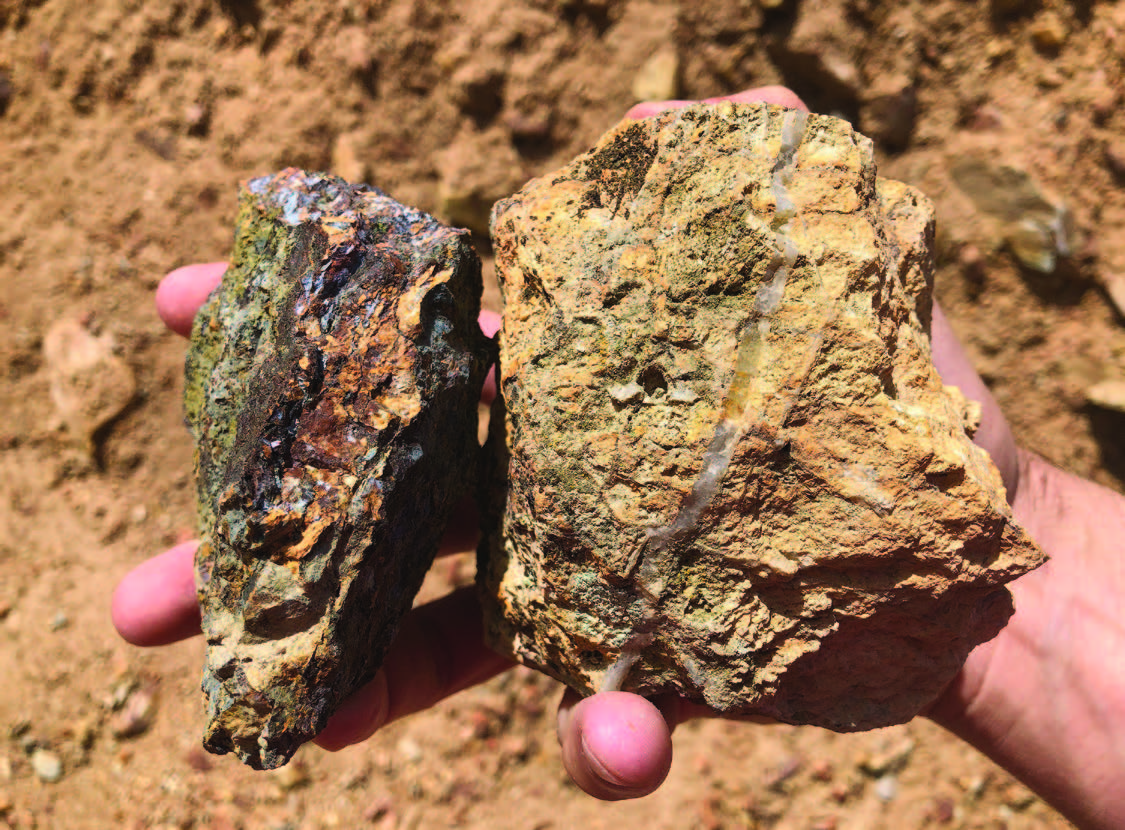
Once profits were made on some of the preliminary ore, Butler and Belle, along with new partners, leased their mining claims by the foot, guaranteeing the lessor 75 percent of all profits. The method brought wealth to both parties, and eventually the Bulters sold their claims to a Philadelphia financier. Soon, the Tonopah Mining Company was formed, with Oddie serving as manager before he was elected to the Nevada State Senate in 1903, Nevada Governor in 1911, and the U.S. Senate in 1921.
Butler’s original rock led to the second largest silver strike in Nevada history, designating the appropriate moniker of Queen of the Silver Camps for Tonopah.
CORNERSTONES
Much has happened in Tonopah since the day Butler picked up that fateful rock. Though unlike many other Nevada sites of historical importance, the Tonopah Historic Mining Park remains beautifully intact, vandal free, and acts as an open-air classroom for those interested in the past.
The park officially opened in 1992, thanks to the hard work and perseverance of those involved in the project. Today, both the town of Tonopah and the Tonopah Historic Mining Park Foundation own the park, and the work to keep it in good repair and authentic is seemingly endless.
“We want to keep the mining park in a state of arrested decay,” says Shari Bombard, Tonopah tourism/events coordinator. “We want people to step back in time when they visit.”
The park is structured with freedom to roam in mind, which is a good thing because it’s tough to stay focused on one piece of cool mining equipment before another pops into view. The layout can be a shock to the senses for those particularly enamored with Nevada mining history, especially considering the sheer volume of information available and the impeccable condition of the exhibits. On that note, though, exhibits may actually be the wrong word. Unlike other museums, these “exhibits” are all the real deal.
MOTHER LODE
Stop by the visitor’s center first. That’s where you can learn about the park and pay the entrance fee. Once you’ve paid, where you go next is entirely up to you. Here are some highlights of the park:
The Mizpah Mine – Belle Butler herself located, named, and christened the Mizpah Mine—also known as Belle’s Mizpah means “watchtower” in Hebrew and can represent both “an agreement between two people” and “an emotional bond between those separated by long distances.” Belle was intimately involved in the mining operations, which was highly unusual for women in the early 1900s. The Mizpah was the largest and top-producing mine in Tonopah, and kept producing long after all the other mines ran dry. In fact, Nevada business magnate Howard Hughes acquired and operated the mine for a brief period. The Mizpah mineshaft, steel head frame, and operations room are all still intact. Guests can stand atop and peer down deep into one of the richest silver mines in the west, and explore the mine hoist in the operations building to understand what mining life was like back then.
The Silver Top Mine & The Grizzly – Once the Butlers sold their claims to investors and the Tonopah Mining Company was formed, work began on the Silver Top Mine. A 1200-foot shaft was topped with a wooden head frame. The mine was in operation from 1902-1948 and is one of three complete hoisting works on property. In addition to the mine and head frame is The Grizzly. The Grizzly—named after the appearance of the rock separator that resembled grizzly bear claws—is where men separated silver ore and waste rock. The rich ore was dumped from ore cars into bins, then straight into railcars that hauled the ore away. The head frame and Grizzly are still very much intact today, and guests have a chance to see piles of waste rock that remain on site.
Tonopah & Goldfield Railroad Trestle – The Tonopah & Goldfield Railroad (T&G) offered service from Mina to Goldfield. The mainline didn’t run directly though Tonopah due to the town’s steep topography, but a spur allowed for ore to be loaded in Tonopah and connected to the mainline at the area around Miller’s roundhouse, located just down the hill. In order for trains to access some of Tonopah’s most prosperous mines, trestles were built to allow the trains to pass over canyons and draws. The Tonopah Historic Mining Park houses one of the last remaining remnants of the T&G—a wooden railroad trestle preserved at its original location inside of the park. Guests get an up-close look at the type of wooden construction that fortunately still stands to this day.
PRESERVE, CONSERVE, RESTORE
While it may seem like a miracle that any of these old structures are still standing, their resilience can’t be attributed solely to engineering perfection in the early 1900s. Along with generous grants, it’s due to the passion of the men and women dedicated to the preservation, conservation, and restoration of these Nevada artifacts.
Shari believes that giving back to the mining park makes sense, considering in some ways, Nevada owes a lot to the mine.
She explains that during a severe bust period, Nevada was supplemented by the profits pulled from the Silver Top Mine. Referring to a recent $100,000 grant provided by the State Historic Preservation office to save the Silver Top Mine, Shari says, “Since the Silver Top once saved Nevada, it makes sense that Nevada now saves the Silver Top.”
In addition to the money collected from admission, the mining park actively seeks donations to help fund major restoration projects. Currently, stress cracks and rotted beams plague the Desert Queen head frame. The park lays custom, engraved bricks to honor and thank those who make donations to these projects. Visit tonopahhistoricminingpark to learn how you can donate.
BACK TO REALITY
The Tonopah Historic Mining Park is special because it protects and simultaneously exhibits our state’s history in a way that allows guests to get up close and personal to the authentic equipment that built Nevada and the west. The general atmosphere lends itself well to the overall historic feel of Tonopah, and its importance in the community resonates. So embrace Jim and Belle’s luck, and let the whitewashed words on the hill guide you to riches. It’s all spelled out for you.

